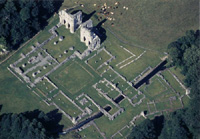 |
 |
 |
 |
 |
 |
 |
|
|
About the Project The Cistercians in Yorkshire Project is funded through the New Opportunities Fund’s ground-breaking £50 million UK-wide digitisation programme which is designed to enable the learning materials and resources currently contained in galleries, communities, libraries, museums, universities and other centres of excellence, to be directly accessible to homes and communities via the internet. The Fund is the biggest of the National Lottery good cause distributors. The Project will focus on five of the Yorkshire houses with significant standing ruins: Fountains, Rievaulx, and Byland principally, but also Roche and Kirkstall. The architecture of each site, explained in the context of other local churches (and European Cistercian abbeys), will open visual and textual windows onto the Cistercian way of life as experienced by the monks, the lay-brothers and their secular neighbours. The Cistercians, or ‘White Monks’ , played a major role in the religious and economic life of medieval England. Among the Yorkshire houses, Fountains and Rievaulx, both founded in 1132, are of notable importance and remain popular with visitors of all ages; Fountains Abbey, indeed, is a World Heritage site. At the centre of the Cistercian way of life lay the spiritual ideal of settling ‘in the desert’ , yet the White Monks were to become significant land-owners in Yorkshire (and beyond) and had a significant, and enduring impact on their local environment. Many modern communities in Yorkshire live on, or near, land that was once owned by the Cistercian Order; residents and local schools will be encouraged, via on-screen prompts, to explore the history of their local area. By incorporating the newest technologies in three-dimensional modelling with rigorous conventional historical and archaeological research and expert architectural analysis of the surviving fabric, this project is genuinely multi-faceted and interdisciplinary. Its mission is to make the fruits of this scholarly research accessible and appealing to the widest possible audience, to show how these ‘bare ruined choirs’ can still sing to a modern, secular age.
In addition to the project team we would also like to thank the following contributors who have made significant contributions to the project and the creation of this site:
|
